Bicycle vacation Cuba
The Tobacco Route and the Salsa Route
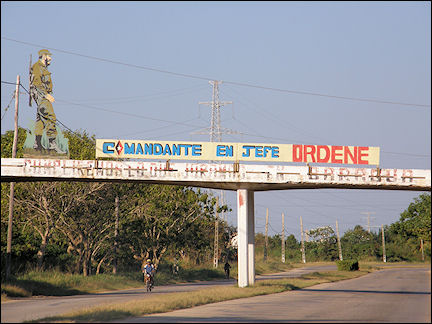
|
These two bicycle routes take you through a large part of Cuba. The mountainous Tobacco Route (427 km) leads from Havana to the Sierra del Rosario in the western province of Piñar del Rio, via Playa el Salado, Las Terrazas, Soroa, Pinar del Rio, Viñales and Canabas. The Salsa Route (830 km) also starts in Havana, but takes you through the flatter, central part of Cuba, along Matanzas, Cienfuegos and Varadero.
Travelogue & photos: Lyda Riedstra
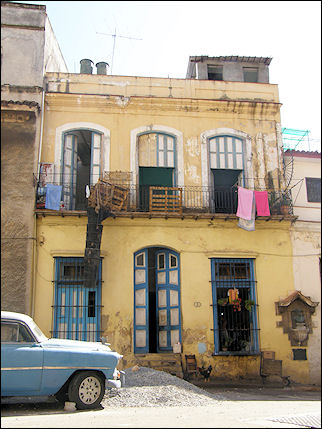
|
On my first day in Cuba I explore the many highlights of Havana by bike. It's a crowded city and the smell of diesel exhaust is everywhere. There are lots of colonial buildings in Havana, some of them dilapidated, but also many that are scaffolded because they're under renovation. Every now and then I see a bus with the name of a Dutch town on it, like Heemskerk.
I will ride two bicycle routes here, which both begin in Havana: the Tobacco Route (427 km) leads through the tobacco region and circles around the Sierra del Rosario in the west of Cuba, via Piñar del Rio; the Salsa Route (830 km) leads through swamp lands and along sugarcane plantations in central Cuba.
Tobacco Route
Families are fishing and have barbecues on the beach
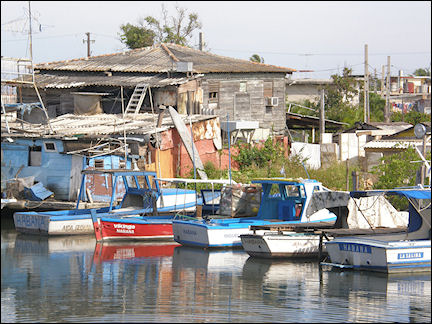
|
After one day in Havana I start on the Tobacco Route. It takes a while to leave Havana: I have to look for street names which are posted only at the lower end of every street. I also have to watch out for broken glass on the road, there is a lot of it.
Eventually I leave Havana in western direction. With the wind in my back I ride via Santa Fe and Baracoa to Playa el Salado, a fishers village 30 km from Havana.
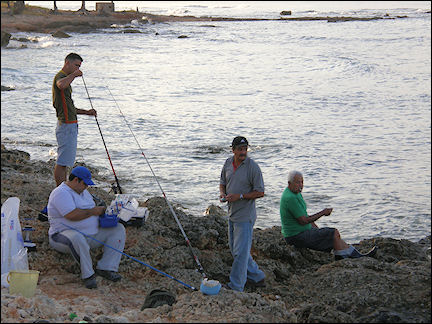
|
On the way I see families on the beach; they are fishing and having barbecues, playing domino and serving themselves lots of local beer. There are also fishers who use angles or simply reels of cotton with hooks at their ends and manage to catch fish. A man proudly shows me the fish he caught.
Adel and Raquel initially don't accept me - a solo biker - as a guest in their casa in Playa el Salado, but they make up for it later with fresh lobster, french fries, tomatoes and chopped cabbage.
Las Terrazas
Horsemen drive cows over the road
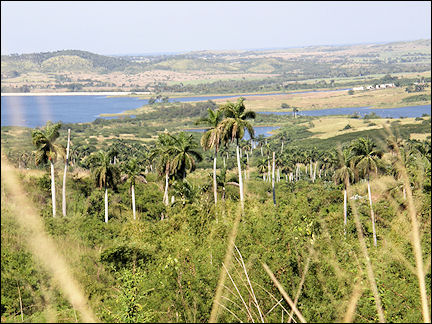
|
The next day the route takes me - with the wind in my back - land inward to Las Terrazas under a burning sun. The route is level to slightly hilly. It is a quiet landscape with every now and then farmhouses, where youngsters fire questions at me every time I take a break.
From the port town of Mariel the ride goes on between sugarcane fields to Guanajay. It's quite an experience to bicycle on the autopista, the four-lane highway, where my sun hat is blown off my head every time a truck passes by. Fortunately I have sisal rope with me to tie my hat to my head.
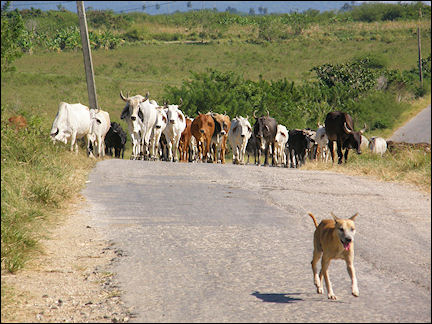
|
It turns out that walking is faster than biking on rural sand roads. There are beautiful panoramic views on the way, via El Mirador to El Establo. While I'm bicycling, I am alarmed by a rumbling sound on the road. Two horsemen are driving cows over the road, towards me. Fortunately, I am faster than the trotting cows.
Las Terrazas is surrounded by wooded hills in a narrow valley above Lago San Juan. Las Terrazas is a model for eco tourism. The village was founded in 1971, in an area that was bare because of excessive logging. The government initiated a replanting program and built an ecological hotel on a hill near the village.
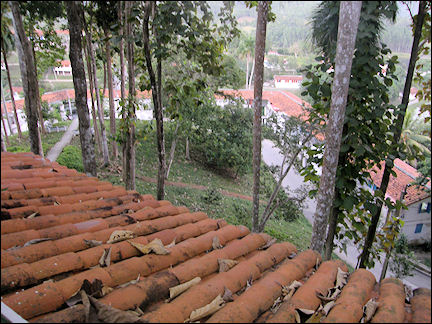
|
Sierra del Rosario, where Las Terrazas is located, is a Unesco-protected nature reserve. In the damp, green forest grow ferns, orchids, begonias and other flowers.
Soroa
Through the green Sierra del Rosario
The leg from Las Terrazas to Soroa in the western part of the Sierra del Rosario turns out to be beautiful but tough. On the way, local people encourage me to keep it up; they call out to me "olla olla" or "bye bye".
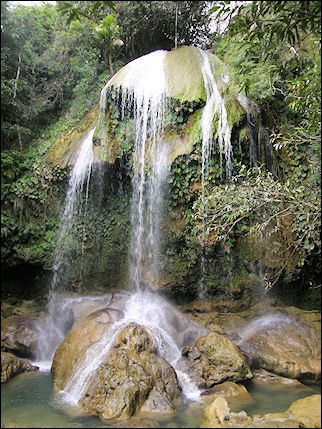
|
Sometimes Cubans on bikes join me for a chat. In that case, when there's a steep climb, I get off my bike and walk: they don't have bikes with gears. They look admiringly at my bicycle bags and ask if I can get those for them as well. They transport stuff in cardboard boxes, sometimes in plastic containers and usually tied with sisal rope to the back seat of their bikes.
I ride through a wooded area with here and there coffee plantations in between. The ride is rewarded with a visit to a waterfall, where a kid - illegally - sells necklaces made of berries.
The 22 meters high waterfall can be reached from the parking lot near the main road, from where a path with steep steps goes all the way down. There also is an orchid garden nearby.
Outside the simple casa (no fan in my room) in Soroa an old man is dozing in a rocking chair, where his granddaughter wakes him gently. The same granddaughter turns out to speak English and also cook for the guests. Spanish tourists, who are staying in the room above me, give me the address of a casa in Viñales.
Pinar del Rio
The tobacco capital of Cuba
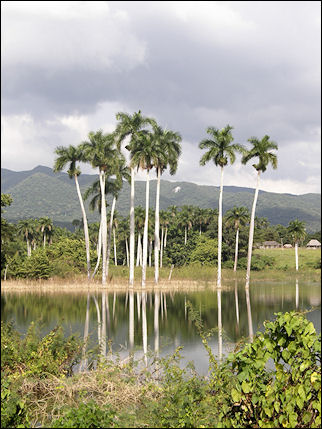
|
From Soroa the route follows the autopista form San Cristobal via Santa Cruz de los Pinos to San Diego de Los Banos. It's a mildly rolling road with every now and then trees in water next to it.
Leaving San Diego de Los Banos, I end up in a group of students who are doing gymnastics in the street. I can't find the spot where the route continues and all of a sudden I find myself on a rickety wooden bridge and breaking one of its planks with my leg. Fortunately a Cuban catches me. Later I see that this road is for the local population. A kilometer away is a sturdy stone bridge.
The route leads between orange groves to Pinar del Rio. On the way a pass by a school and I notice that the subject matter is collectively rattled off by the class.
Once I see a soldier get out of his car and firmly address the students during the hoisting of the Cuban flag.
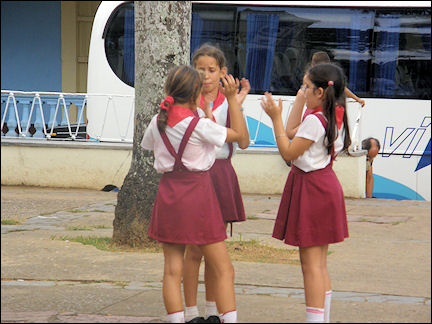
|
To my surprise I once see a group of students lined up along the road to encourage me to make it to the top of the hill.
Every hamlet has a busy central spot from where people are transported in trucks. Some trucks require people to climb on them and then people will be transported while standing on the loading platform.
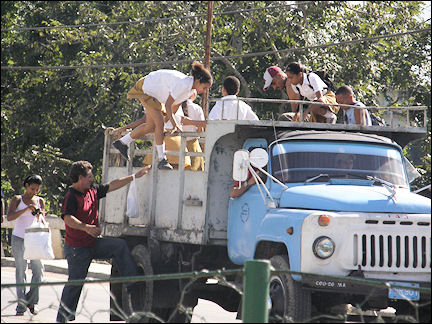
|
Sometimes there is a ladder at a stop. But often children and elderly people are hoisted up by strong people into the truck and at their destinations put back on the ground not very gently.
Many people do their work outdoors: hairdressers, mechanics, bicycle repair men, gas and bread vendors, key makers, tailors and cobblers. There are hardly any cell phones, but still most phone calls are made outdoors.
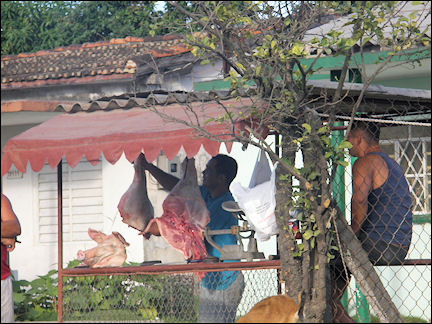
|
Sometimes I pass by stalls where cow cadavers are lying in the burning sun. In bigger towns and along the road are trailer stores that sell water and candy by the piece.
For bicyclists it's advisable though to bring sufficient drinking water for the whole day: there are not always restaurants, supermarkets of shops nearby.
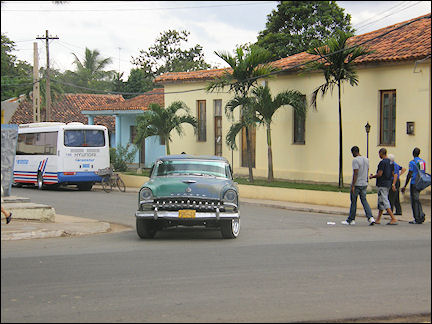
|
Pinar del Rio, a province town with pastel-colored houses, is Cuba's tobacco capital. Here you find the famous cigar workshops where the best Cuban cigars are made.
In larger towns like Pinar del Rio you see long lines at banks, ice-cream parlors and supermarkets. In small villages people get bread by paying with vouchers.
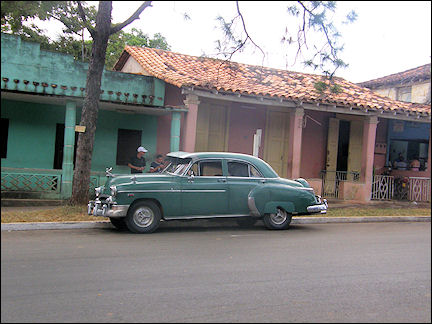
|
After some days of bicycling in the countryside the exhaust fumes of cars in the cities are unpleasant enought to want to leave immediately and that is what I do in Pinar del Rio.
Viñales
A valley with limestone rocks
The route continues northward to Viñales. Half way, there is a long and difficult, but beautiful climb with a view in the distance of limestone rocks (mogotes) in the valley of Viñales.
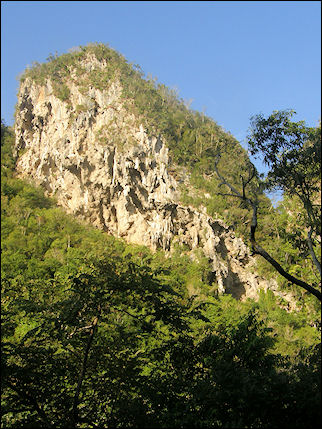
|
I often see women in open spaces underneath lean-tos checking and sorting tobacco leaves. On the way to Viñales I visit a tobacco shed. The cigars for tourists are very expensive.
Viñales is a pleasant touristic town in a beautiful valley between Sierra de los Organos and Sierra del Rosario. I spend the night in a simple casa where the guestrooms are more luxury than those of the owners. In most casas my bike spends the night in my room.
I get fish for dinner and tortilla for breakfast every day. In combination with the hot, often muggy weather, my intestines apparently don't tolerate this diet. So now I ask just for vegetables and fruit, which the Cubans think is strange. They want to take good care of their guests.
Canabas
Along banana plantations, sugercane and rice fields
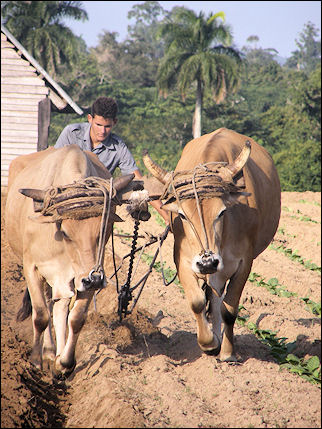
|
The road to La Mulata on the north coast requires special attentiveness because of the many potholes. I am surprised to see people work the land with oxen.
All of a sudden a pig jumps right in front of my bike; it was chased off a property. It is not unusual to see pigs on leashes being walked by their owners.
The road leads along banana plantations, sugarcane and rice fields; every now and then I have a view of the sea. It is a special experience to spend the night in a simple farmhouse.
The route continues along the coast. I ride my bike through beautiful surroundings to Cabanas, a simple small town. On the way I am shocked when I see a man, who walks with a sturdy cane, pull another man (his son?) along on a rope.
In Canabas I am once again accosted by a young man who tries to give me directions to an accommodation of his choice. Tenaciously I keep pointing at an address from the Lonely Planet. Often this annoys or even angers the guys who are offering accommodation, because this way they won't get any commission.
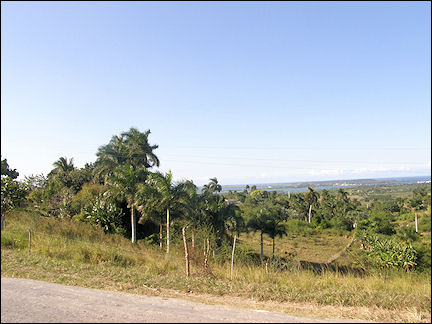
|
I am surprised to see that the house where I spend the night has a pool. Outages often happen during my trip, also here. Sometimes there's no water and you can't flush the toilet. These inconveniences make me admire the Cubans even more, because of the relaxed way they deal with them.
On the way along the north shore, back to Havana, there is a strong eastern headwind, which is especially bad when you have to climb a hill. The coastal road eventually takes me back to Havana.
Salsa Route
Along nodding-donkey pumps and anti-imperialist billboards
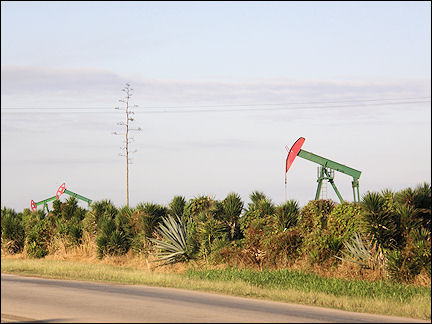
|
The Salsa Route leads begins in Havana and leads southeast, toward Trinidad. The first part goes east along the north shore. Because the tunnel is not accessible for bikers, I take a Ciclo bus to get to the other side.
The route first goes to Guanabo, a lively town along the shore, via Santa Maria del Mar. From Guanabo I bicycle along nodding-donkey pumps to Matanzas.
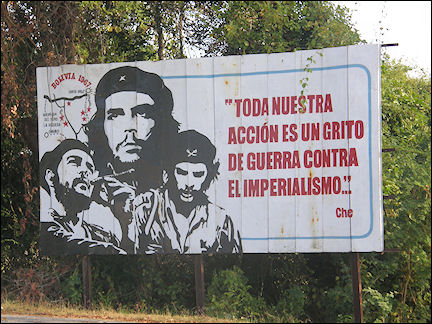
|
Every town has portraits of heroes from Cuban history. In every hamlet you are welcomed with educational texts by Che Guevara, Fidel Castro and José Marti.
The message always is that they have liberated Cuba with their revolution. The texts are usually aimed at imperialism, like the ones that say "Down with imperialism" and "Unity guarantees victory".
Matanzas
Birds of prey circle above the Yumuri Valley
After passing S. Cruz del Norte, during a steep climb, I see women who are selling bananas and cheese. The road takes me to a large bridge over the Bacunayagua River canyon.
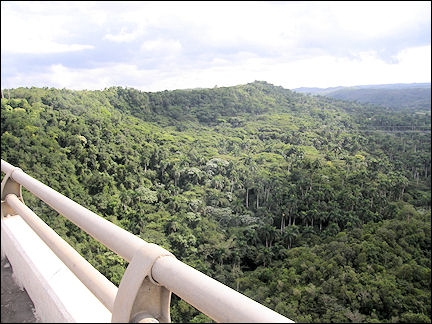
|
The 112 meters tall bridge, the largest of Cuba, was finished in 1960. On the left side I see the Atlantic Ocean and on the right side the gorgeous Yumuri Valley above which birds of prey circle.
After a short but heavy rain shower I arrive in Matanzas, an industrial port town. In the 19th century Matanzas was the sugar capital of Cuba. It's still visible that in those times the sugar industry used African slaves: the city is a center of African-Cuban culture.
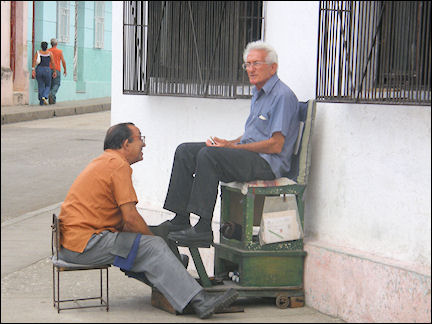
|
The casas I found in the guidebooks are full but, as usual, family members are found who will put me up. They don't speak English, but find an English-speaking relative to apologize when the lady of the house opens the bathroom door by accident while I'm in there.
Matanzas is located on a bay and the old center with its narrow alleys still shows traces of its earlier heyday. Especially around Parque de La Libertad there are houses with columns, cast-iron balconies and tile mosaics.
Cienfuegos
The city center has a French colonial atmosphere
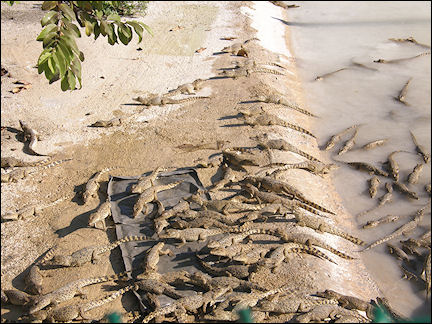
|
From Matanzas I bicycle southeast, inland; it's a long and flat route. The landscape is dominated by sugarcane and citrus groves when I arrive at the hamlet of Jaquey Grande.
A little later I pass by an alligator farm. There are separate basins for every age group: one-year-olds, two-year-olds, etc. On the way I see how the leaves that are used to make straw hats, are mowed.
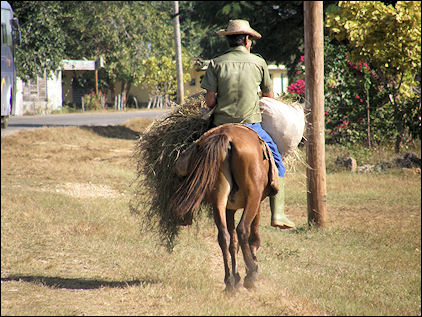
|
To Playa Giron, on the Bay of Pigs, I bicycle on long, deserted roads through a swamp area with lots of waterbirds and birds of prey. My casa in Playa Giron lies near a quiet beach where you can swim in the clear sea and sit in the shadow of palmtrees, enjoying the view of the sea.
The leg from Playa Giron to the port town of Cienfuegos also leads through a swamp area and along sugar plantations. The recurring sound of horses makes this leg of the trip cozy. On the way, I find a horse shoe and take it with me as a memento.
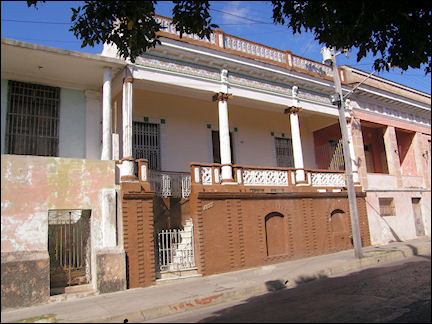
|
Cienfuegos has lots of colonial buildings, which sometimes house casas. It feels like luxury to spend the night in one of them. Cienfuegos is quieter than the bigger towns I saw before and has the atmosphere of the (French) colonial past, especially in the old town center.
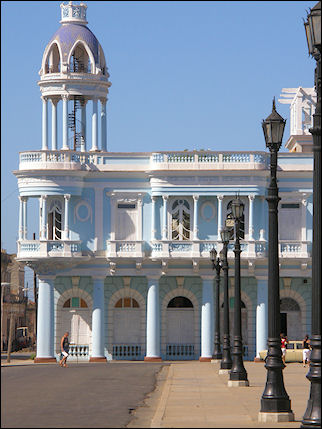
|
Much transportation in Cienfuegos happens by horse carriages. On Sundays families take their children by horse-and-wagon to (sometimes rusty) playgrounds. For the adults there is locally brewed beer on draught and for the children lemonade.
Sometimes Cubans bring a bottle of rum and plastic cups. Everyone they chat with gets a bit of rum. For tourists there is different rum and cigars. Once I succeed in acquiring local cigars, but they are un-smokeable: very heavy to take a draw.
Varadero
Every hamlet on the way has a hospital
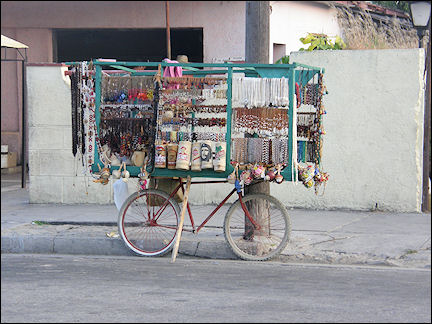
|
From Cienfuegos I ride inland to Santa Clara, a place of pilgrimage for Che fans from all over the world. Che Guevara's remains are kept in the Museum Memoria del Ernesto Guevara here.
The fields on the way are worked by farmers with oxen and the grass in mowed by men with machetes, who earn a meager income with this. During my bike trips, Cubans often approach me for a chat or help me to find a place to stay for the night.
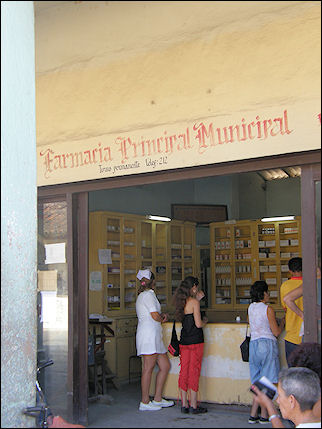
|
Every hamlet on the way has a hospital. Health care and education are well developed in Cuba. But the pharmacies look as if it's still the 1950s.
Because young people in Cuba are well-educated, there are hardly any fitting jobs for them. There is a lot of work in agriculture, which is not attractive for them because it's hard labor and badly paid.
From Santa Clara the route goes over long, monotonous and hot roads via Santo Domingo to Corrallilo on the north shore and then west to Varadero, a tourist resort.
People are allowed to enter banks here only one at a time. Only when a customer is leaving, the next one is allowed in.
Havana
Malecon is crowded with rum drinking young and old people
After a couple of days in Varadero I conclude my bicycle tour with the last leg, via Matanzas to Havana, where I spend the last evening in Malecon, the miles-long promenade which is every now and then wet with surf water. Malecon is busy with fishermen, peddlers of simple fishing gear, stalls, musicians and (mostly) young and old people drinking lots of rum.
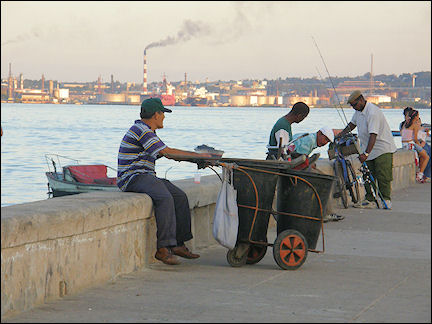
|
I notice at some point that (mainly elderly) men and women retrieve cans and plastic bottles from public trash cans. Returning them to some of the larger stores or restaurants will yield them a little spending money.
Cubans are in general friendly, hospitable and happy with the small things life has to offer, especially in the countryside. Inconveniences are dealt with in a laid-back way. With the few means at their disposal, Cubans usually find solutions for most of their problems. Plastic bags are used for many different purposes: as kites, or to fill with water or sand on the beach. And you can see women walk around with empty toilet-paper rolls for curling pins.
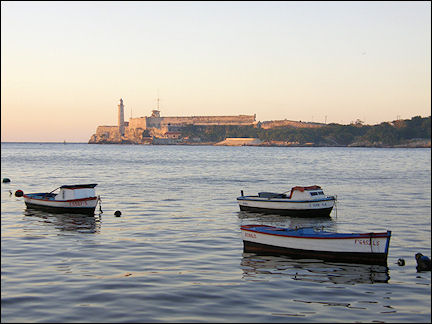
|
It is a special experience to be a western bicyclist, riding around in freedom in a country that is less than free. When you stay in Cuba for a longer while, you find out that every hamlet has its invisible social control. It's often old men who keep an eye on what's going on in a hamlet or part of a town.
Speaking with young people it became clear to me that they crave economic change, which they hope will make it possible for them to own the capitalist gadgets they see tourists with, like cell phones and lap-top computers.